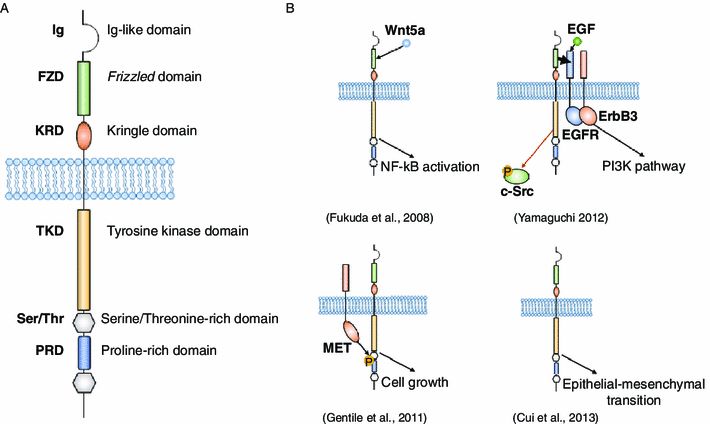PD-1 and its ligands PD-L1 and CTLA4 are currently the most commonly used targets for immune checkpoint inhibition. However, emerging checkpoints continue to be discovered, providing additional options for immunotherapy.
Tyrosine kinase-like orphan receptor 1 (ROR1) has gained attention as a potential immune checkpoint. Creative Biolabs describes the emerging role of ROR1 in the immune checkpoint arena and offers services to explore more possibilities.
ROR1 is a transmembrane protein that has historically been studied in the context of embryonic development. ROR1 is highly expressed in a variety of hematological cancers and solid tumors, and it plays an important role in promoting tumor growth and metastasis, inducing drug resistance in tumor cells, and inhibiting apoptosis. Its renaissance in cancer has piqued the interest of researchers and sparked an exploration of its role as an immune checkpoint.
 Fig. 1 ROR1 structure and signaling in cancer.1,2
Fig. 1 ROR1 structure and signaling in cancer.1,2
Below are some key aspects of ROR1's involvement in cancer immune evasion.
Due to the low level of ROR1 expression in normal adult tissues and high expression in solid tumors, ROR1 targets have been favored by pharmaceutical companies since 2020, with a variety of therapeutic modalities being developed, including antibody-coupled drugs (ADCs), monoclonal antibodies, bispecific antibodies, and CAR-T therapies, with ADCs being the most promising direction.
The ROR1-ADC class of drugs currently under investigation is mainly targeting hematological and solid tumors.
ROR1 is a very promising and noteworthy target, and its emergence as a potential immune checkpoint opens up new and exciting possibilities in the fight against cancer. At Creative Biolabs, we are at the forefront of these advances, working tirelessly to explore and assay immune checkpoints and to translate this knowledge into innovative therapies.
References
All listed customized services & products are for research use only, not intended for pharmaceutical, diagnostic, therapeutic, or any in vivo human use.
USA
Tel:
Fax:
Email:
Copyright © 2026 Creative Biolabs. All Rights Reserved.